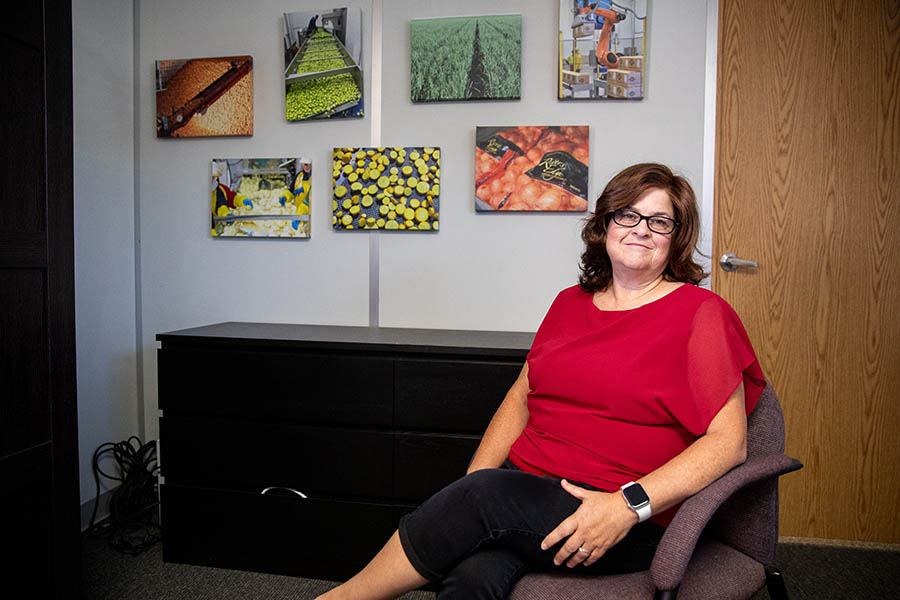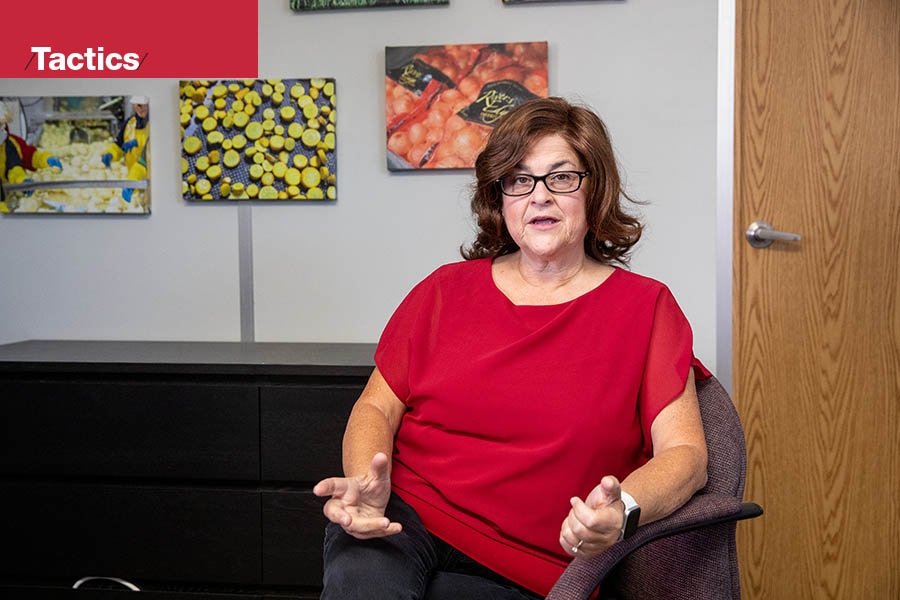For Debbie Radie, Boardman Foods Is a Family Affair
Debbie Radie, now VP of operations for Boardman Foods, started working for the company when it was situated in the Willamette Valley. Then 27 years old, she relocated from San Diego, Calif., to work for the company, where she has spent the last 32 years. In 1992 the company relocated to Boardman to be closer to both the raw materials — then, just onions — and the Port of Morrow. At the beginning of Radie’s tenure, the company had 69 employees; now it has as many as 300 at peak times. The company has also expanded its product offerings, processing peppers, squash, cucumbers, celery and shallots.
Radie’s parents were the first employees of Boardman Foods. Her husband, Dave Radie, serves as the company’s director of logistics. And her grown son is in the family business as well, providing information technology services for a different food-processing company.
It’s also a family affair in that Radie — with the help of community partners — has taken strides to ensure employees and their children are well cared for. Seven–teen years ago, Radie helped create an after-school child care center for children of employees; earlier this year, the center became a community-wide project.
This interview has been edited for length and clarity.
What are some of the challenges that you’ve seen in the food-manufacturing industry in the last couple of years?
Well, the last two years have definitely been different than any year that we have been in business, primarily due to the COVID pandemic. I think the challenges of that have brought about a sense of urgency for our company, and a sense of purpose. It’s really brought to life how important what we do every day is to the American food supply.
What are some of the problems you didn’t anticipate?
Most recently, the thing that maybe caught us off guard was inflation, including the cost of wood, for example, which is an item that we need to make pallets. In combination with not having labor to actually build and repair the pallets, we actually have wood prices that skyrocketed. So even though the wood prices now have come down, the cost of those pallets hasn’t come down from the suppliers: There’s such a great built-up demand that something like that can shut down an operation like ours without having the pallet to put that product on. So it’s things like that, that you may not expect would be an impact on a food-manufacturing plant, that can really be the thing that you have to focus a lot of your attention and time on.
What about workforce issues?
We’ve capitalized on adding new technology over many years, but particularly in the last three or four years — and continue to add new technology that supports what we do in a way that our people get to learn something new. It’s less labor intensive for them, specifically, but they also get to play. You get to work alongside a big piece of equipment rather than being the piece of equipment your own self. An example of that is palletizing, where we take 45-pound boxes and put them on a pallet, and we’ll stack them up to about 4 feet high. Well, that’s a lot of bending and can be [a cause of] back injuries. Thankfully, we didn’t have any, but it’s still one of those things where you get wear and tear on employees. In 2017 we put in a robot that picks up two cases at a time and gently places them on the pallet, builds that pallet, stretch wraps it and puts it all together for us. Our employees get to learn how to use that robot and play alongside of it. People will stand and stop and just watch it because it is really fascinating. The employees at our plant named the robot Sam, after my dad, who retired and just recently passed away. He’s a workhorse and he’s part of our culture there, and it really is endearing to see people appreciating that technology and not be afraid of it, but be excited about it and know that this is something that’s going to help the future of Boardman Foods be stronger, and be able to do more volume and not do it at the expense of an employee’s back.
And child care is something you’ve been interested in as well.
About 17 years ago, I got a passion to start something at the plant that would allow parents to continue their workday without the worry of where their young children were going after school. I worked with the superintendent at the school district and created an after-school facility where kids could get a snack and have aides look and see if there’s homework that they could assist them in — and then wait for their parents to get off work and take them home. When COVID happened, we noticed that parents were really struggling with staying working — some of them were both the mother and father working. We got permission from the state of Oregon through the licensing board to allow school-age children to come all day to our after-school program. And there was such a need that there were people in the community going, “How do we get our kids into that program? You know, we need that too.”
The Port of Morrow decided to add on to its Early Learning Center, and so they approached us when they saw what we were doing, and said, “Would you be interested in taking on that brand-new facility with some additional classroom space so that you could offer child care services to the entire community?” We looked at it and said, “We’ll start with allowing other people in the community to come into our school-age program. Then we’ll add toddlers and infants — just a small room, eight or 10 people.” There was already a preschool program going on, so we elected just to let them continue with their program. We fill in the blanks.
We started that up in January of this year. There was strong encouragement by the community for us to continue and to also look at other companies that would potentially be interested in supporting it, so that we could lower our rate per month to the working families, because a lot of the families could not afford the $1,200 or $1,500 a month that it costs for licensed care. Doing a survey, we found that about $600 a month is what our community could afford. So there’s a big gap there. And so we went out to other businesses and said, “Would you be interested in partnering with us to offer [child care] services in the community to more children and families?” And we did get quite a few people that said, “Yes, we would, too.” We’re still working on that funding campaign. Our opportunity here is to have a private partnership that allows this program to succeed with the sponsor, corporate sponsors and the parents’ input of their finances.
Do you think that’s affected staffing and retention?
There are a few parents who are with Boardman Foods who have utilized the program and are supportive and appreciative of it. But I wouldn’t say we consider it — nor do many of the sponsors — as a retention tool. What we’re looking for is to create a community in which people see that there are resources available to them to make our community their new home. We’re trying to attract skilled labor: electricians, plumbers, refrigeration technicians, truck drivers, forklift drivers, supervisors, managers — in our area, almost every type of position that you can think of is needed. So to attract those working moms and dads — young moms and dads who are saying, “Where am I going to put my kids if I move to Boardman, Oregon?” — this helps them feel that secure place that they can work and not worry about what’s happening with their children while they’re working. That’s more of the driver in terms of how it’s going to impact future generations and how it’s going to affect the future of Boardman Foods. For the other companies, as well, it’s “What are we doing to make a livable and sustainable community for families that are interested in coming and looking at our places to raise their family?”
 Photo: Jason E. Kaplan
Photo: Jason E. Kaplan
What do you think people may not realize about what happens to their food before it reaches the grocery store or before it hits their table?
The cleanliness of a food-production plant is so documented, so precise and so proceduralized and vetted over the years. We have basically a giant kitchen that you would have in your own home — but we have a giant kitchen that probably is cleaner than most home kitchens. We think of what we’re doing as feeding people. We know that what we touch and how we handle it and what we look at affects somebody’s physical health and well-being. And we’re really proud of that, and we take it very, very seriously. So those precise things that we do, like checking metal detectors, verifying equipment is working, looking at a time and temperature of cooking — it’s very a precise recipe that we’re doing to make sure our products that we ship out every day are wholesome. We take a lot of pride in what we do. We believe that everyone in our facility comes to work wanting to do the very best job they can every day. And it’s up to us to train them, to help them understand what’s important about what we do, and why we do it for them to be successful.
To subscribe to Oregon Business, click here.








